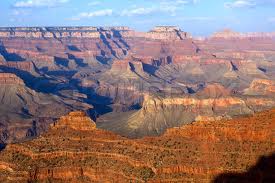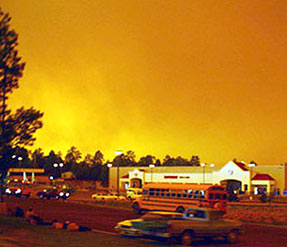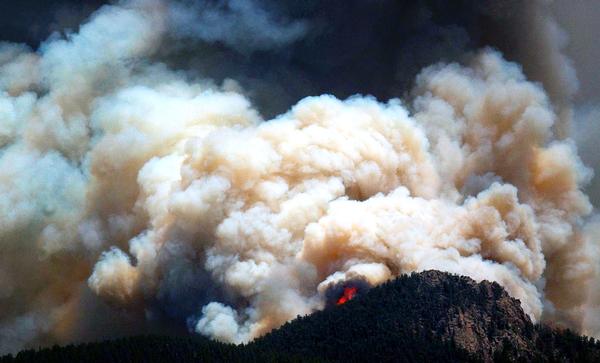|
6. Relations between climate variability and change and western forest fires Climatology, variability and trends in United States vapor pressure deficit, an important fire-related meteorological quantity - PDF Unlike the commonly used relative humidity, vapor pressure deficit (V PD), is an absolute measure of the difference between the water vapor content of the air and its saturation value and an accurate metric of the ability of the atmosphere to extract moisture from the land surface. V PD has been shown to be closely related to variability in burned forest area in the western United States. Here the climatology, variability and trends in V PD across the U.S. are presented. V PD reaches its climatological maximum in summer in the interior southwest U.S. due to both high temperatures and low vapor pressure under the influence of the northerly, subsiding eastern flank of the Pacific subtropical anticyclone. Maxima of variance of V PD are in the southwest and southern Plains in spring and summer and are to a large extent driven by temperature variance but vapor pressure variance is also important in the southwest. La Niña-induced circulation anomalies cause subsiding, northerly flow that drive down actual vapor pressure and increase saturation vapor pressure in fall through spring. High spring and summer V PD can also be caused by reduced precipitation in preceding months, as measured by Bowen ratio anomalies. A case study of 2002 leading up to the Rodeo-Chediski, AZ, nd Hayman, CO. fires shows very high V PD caused by antecedent surface drying and subsidence warming and drying of the atmosphere. V PD has increased in the southwest U.S. since 1961, driven by warming and a drop in actual vapor pressure, but decreased in the northern Plains and midwest, driven by an increase in actual vapor pressure.
Correlations between components of the water balance and burned area reveal new insights for predicting forest fire area in the southwest United States - PDF We related measurements of annual burned area in the southwest United States during 1984–2013 to records of climate variability. Within forests, annual burned area correlated at least as strongly with spring–summer vapour pressure deficit (VPD) as with 14 other drought-related metrics, including more complex metrics that explicitly represent fuel moisture. Particularly strong correlations with VPD arise partly because this term dictates the atmospheric moisture demand. Additionally, VPD responds to moisture supply, which is difficult to measure and model regionally due to complex micrometeorology, land cover and terrain. Thus, VPD appears to be a simple and holistic indicator of regional water balance. Coupled with the well-known positive influence of prior-year cold season precipitation on fuel availability and connectivity, VPD may be utilised for burned area forecasts and also to infer future trends, though these are subject to other complicating factors such as land cover change and management. Assuming an aggressive greenhouse gas emissions scenario, climate models predict mean spring–summer VPD will exceed the highest recorded values in the southwest in nearly 40% of years by the middle of this century. These results forewarn of continued increases in burned forest area in the southwest United States, and likely elsewhere, when fuels are not limiting. Causes and implications of extreme atmospheric moisture demand during the recordbreaking 2011 wildfire season in the southwest United States - PDF In 2011, exceptionally low atmospheric moisture content combined with moderately high temperatures to produce record-high vapor-pressure deficit (VPD) in the southwestern United States (SW). These conditions combined with record-low cold-season precipitation to cause widespread drought and extreme wildfires. Although interannual VPD variability is generally dominated by temperature, high VPD in 2011 was also driven by lack of atmospheric moisture. May–July 2011 dew point in the SW was 5.1 standard deviations below the long-term mean. Lack of atmospheric moisture was promoted by already very dry soils and amplified by a strong ocean-to-continent sea-level pressure gradient and upper-level convergence that drove dry northerly winds and subsidence upwind of and over the SW. Subsidence drove divergence of rapid and dry surface winds over the SW, suppressing southerly moisture imports and removing moisture from already dry soils. By the 2050s, model projections developed for the fifth phase of the Coupled Model Intercomparison Project (CMIP5) suggest that warming trends will cause mean warm-season VPD to be comparable to the record-high VPD observed in 2011. CMIP5 projections also suggest increased interannual variability of VPD, independent of trends in background mean levels, due to increased variability of dew point, temperature, vapor pressure, and saturation vapor pressure. Increased variability in VPD translates to increased probability of 2011-type VPD anomalies, which would be superimposed on ever-greater background VPD levels. While temperature will continue to be the primary driver of interannual VPD variability, 2011 served as an important reminder that atmospheric moisture content can also drive impactful VPD anomalies. REFERENCES
|
 EASM2: LINKING NEAR-TERM FUTURE CHANGES IN WEATHER AND HYDROCLIMATE IN WESTERN NORTH AMERICA TO ADAPTATION FOR ECOSYSTEM AND WATER MANAGEMENT EASM2: LINKING NEAR-TERM FUTURE CHANGES IN WEATHER AND HYDROCLIMATE IN WESTERN NORTH AMERICA TO ADAPTATION FOR ECOSYSTEM AND WATER MANAGEMENT | |
| Lamont-Doherty Earth Observatory of Columbia University 61 Route 9W Palisades, NY 10964
| |
|
| |

